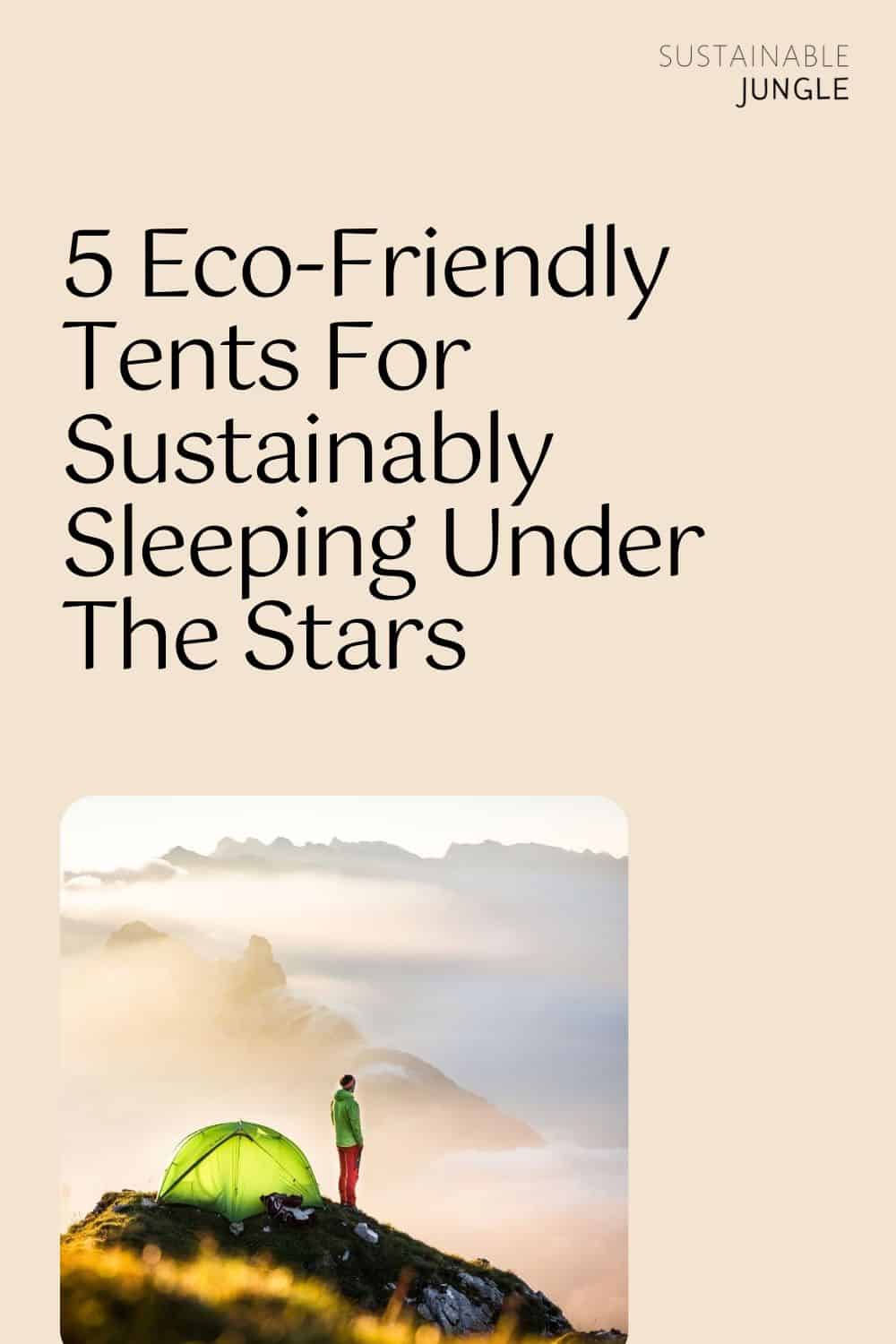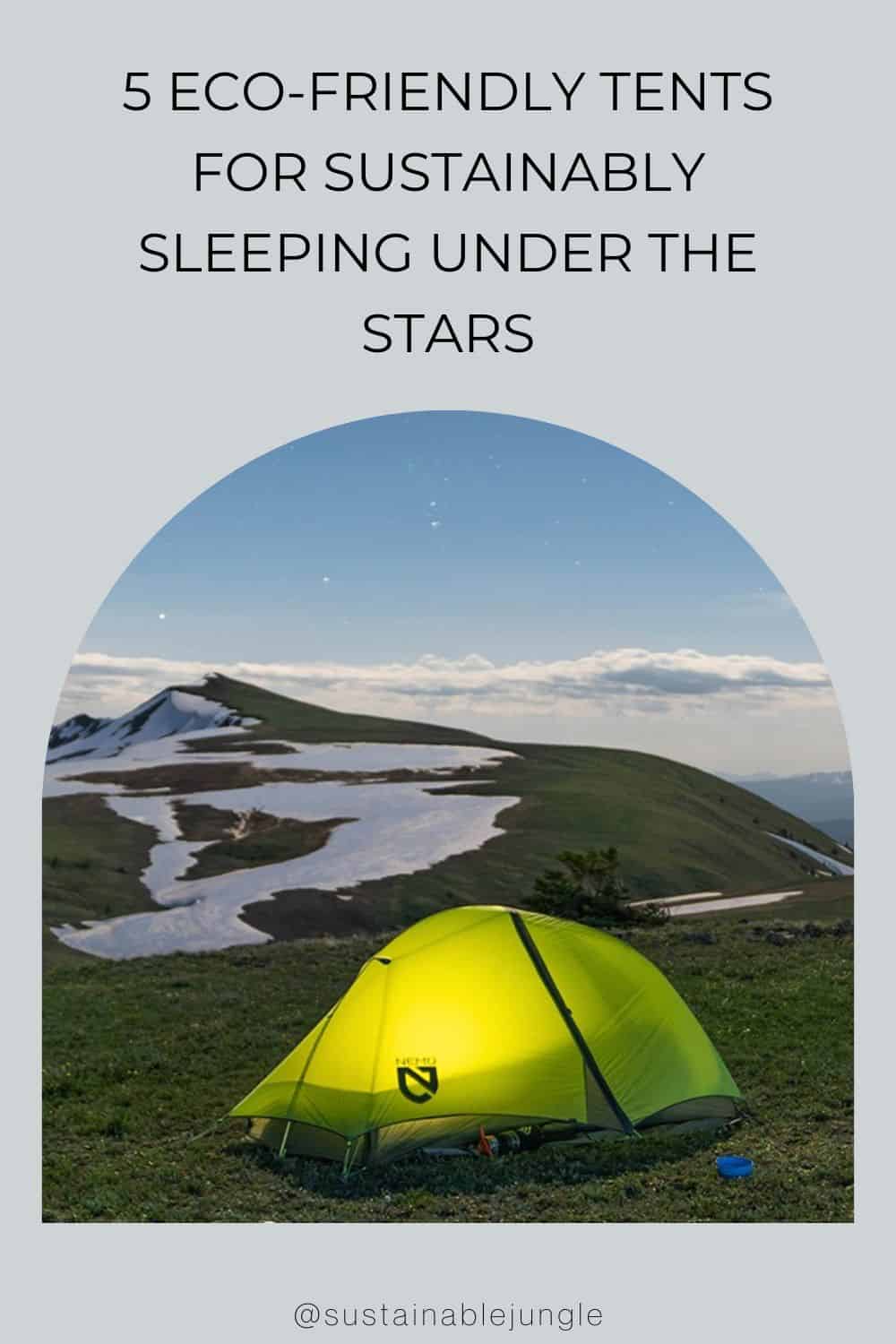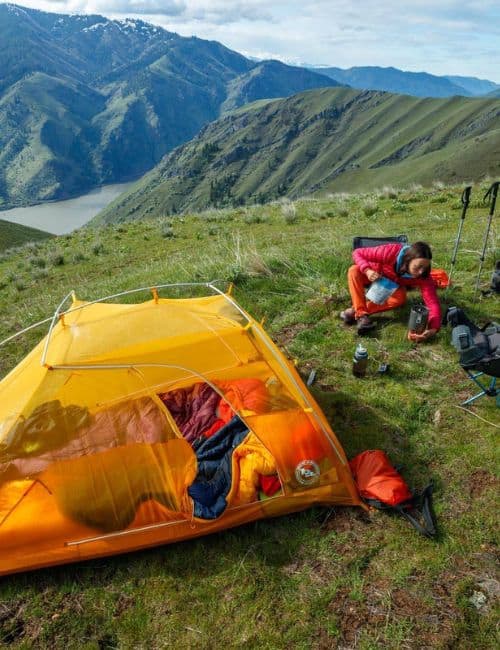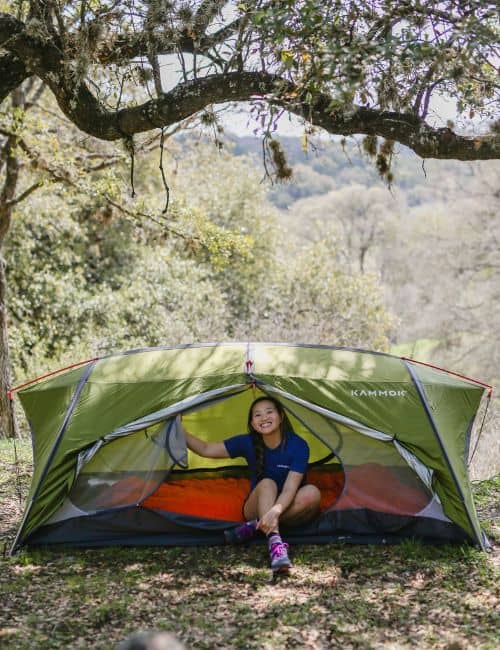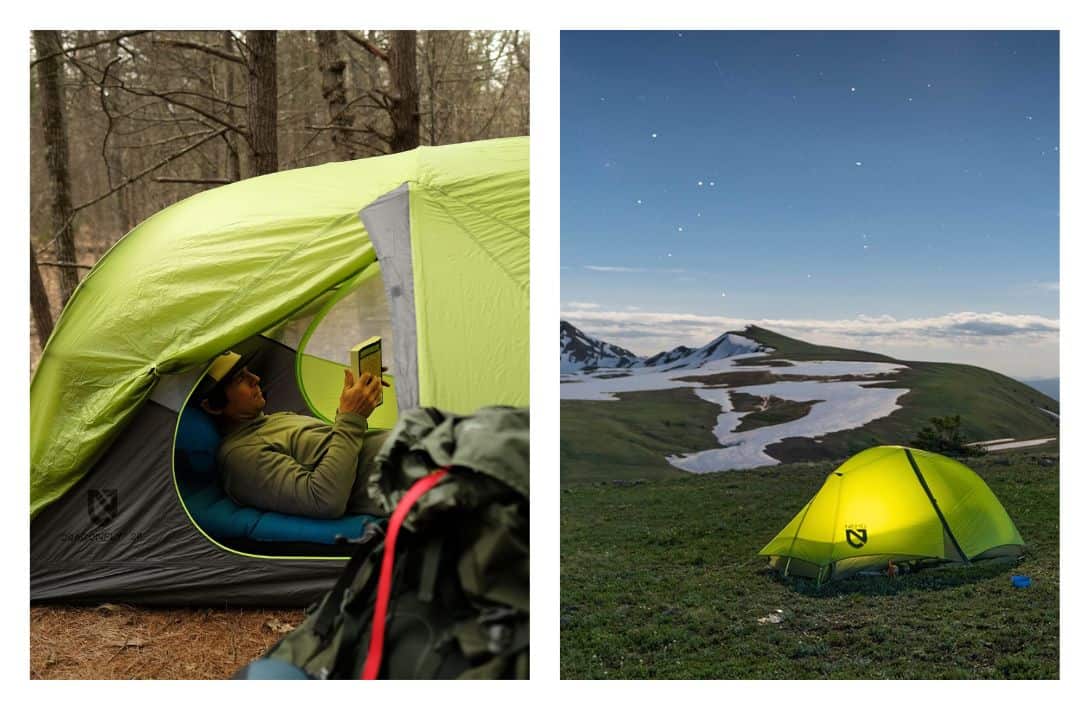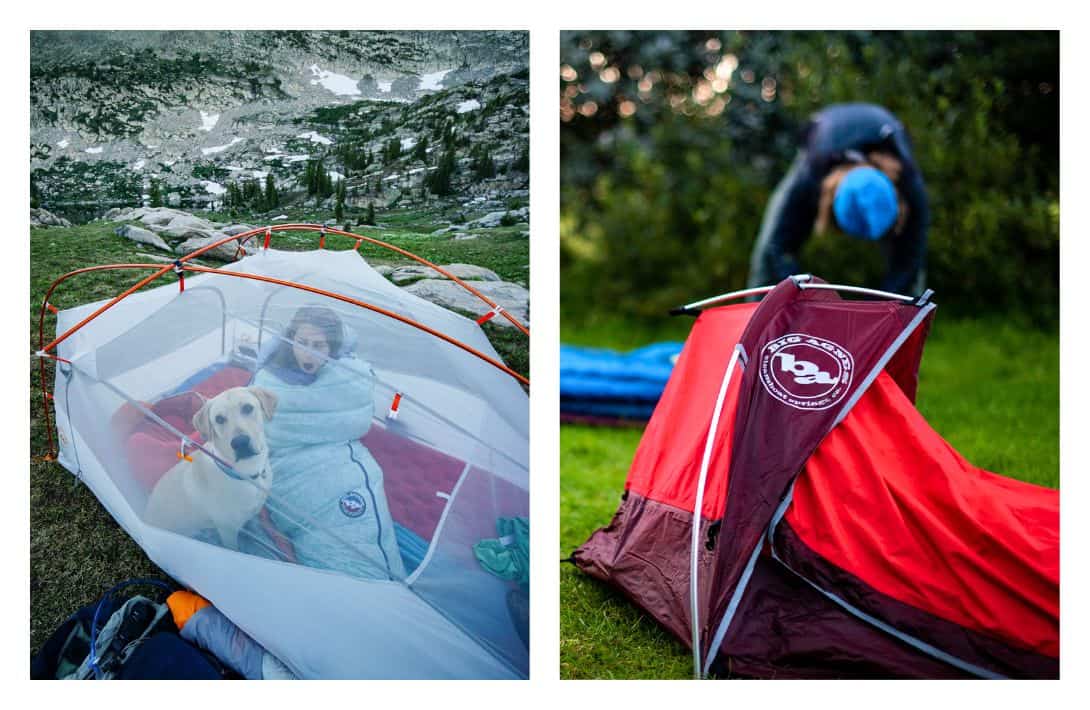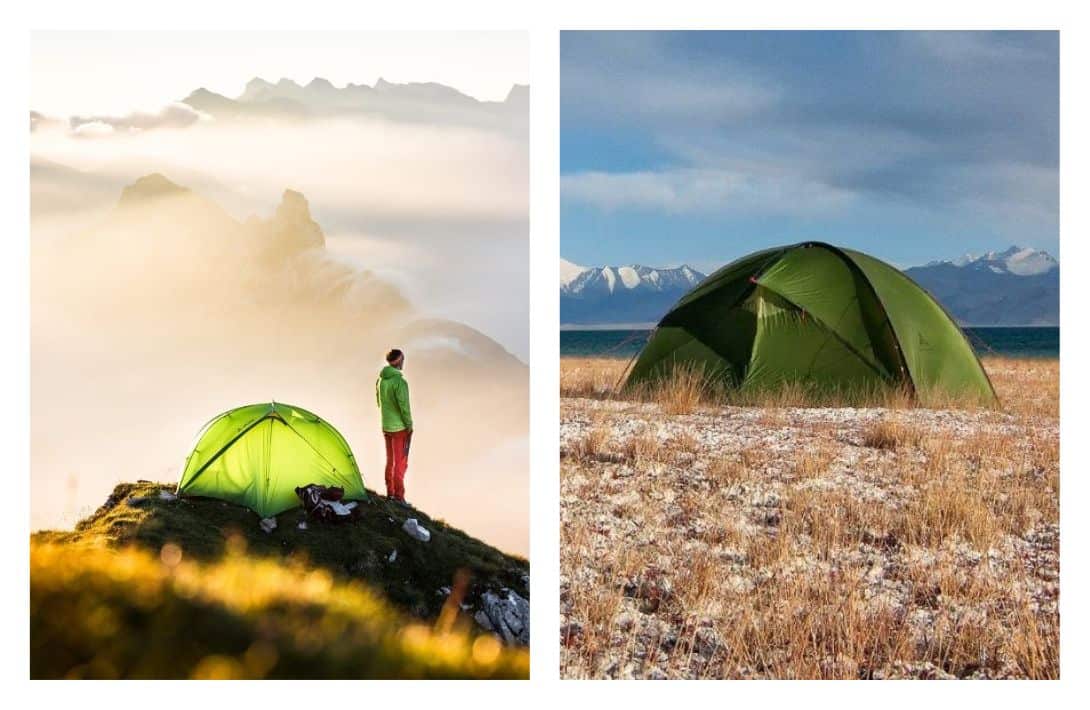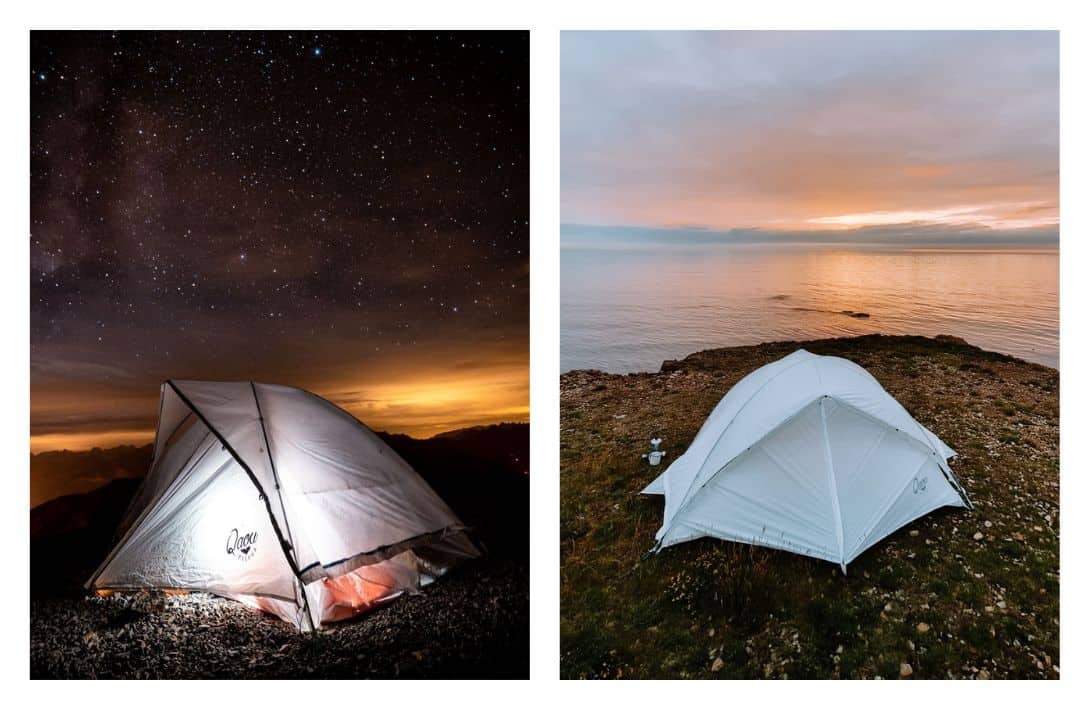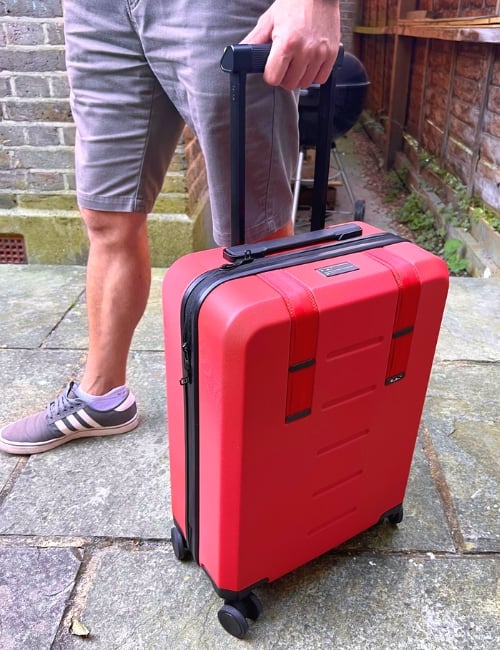5 Eco-Friendly Tents You Can (Sustainably) Sleep Under The Stars In
Pitch a tent and save the planet?
Now, there’s an idea worth putting some (tent) stakes in—but eco-friendly tents are almost as hard to come by as they are to fit back in their stuff sack.
Combining sustainable materials with the durability required to withstand the great outdoors isn’t easy, but that only makes these sustainable tents all the more diamonds in the dirt.
Not every brand on our list uses 100% renewable materials, but they’re putting a dent in the fight against climate change by taking the first step toward supporting the environment and eco camping trips to come.
Everything we recommend to you on Sustainable Jungle is independently researched and we ask all brands to confirm their claims. To avoid waste, we test products on an as needed basis. This post contains affiliate links. If you buy something through our links, we may earn a small commission. Learn more about why we do this here.
The Top Sustainable Tent Brands In-Tent On Saving the Planet
NEMO uses 100% recycled tent fabric to produce sustainable camping tents that don’t compromise on durability or lightweight design. Their lifetime warranty is the s’mores at the end of the day.
Kammok’s light hammock tents are ideal for relaxing under the night sky after a long hiking trip. You’ll sleep even better knowing they’re a Certified B Corp and Climate Neutral.
If you’re feeling tent-sitive, hike over to the bottom to read up on criteria for eco-friendly camping gear and how we used it to find the most eco-friendly tents for sale.
The Most Sustainable Shoe Brands
1. NEMO
About NEMO
Price Range: $199–$899
NEMO produces some of the best sustainable tents on the market.
The company utilizes recycled materials and smart design principles to develop ultralight tents made from recycled materials and suited for harsh weather conditions.
The best part?
Their lifetime warranty, gear trade-in program, and repair guides will help you get the most out of your camping gear.
NEMO’s Ethical & Sustainability Practices
Materials:
NEMO has stepped up its sustainable tent materials with the Dagger OSMO, a lightweight backpacking tent made from 100% recycled fabric.
NEMO uses a proprietary recycled tent fabric and PFC/PFAC-free water repellency, keeping you dry for longer. It meets fire retardancy standards without any harmful chemicals.
They’re also a bluesign® system partner, ensuring responsible production of textiles by prohibiting harmful chemicals.
Supply chain & labor practices:
NEMO works with suppliers that adhere to ILO labor standards, requiring all partners to sign a code of conduct covering fair wages, working hours, and safe working conditions.
NEMO also conducts regular audits of its partners to ensure compliance with these strict environmental guidelines.
Carbon commitments & green business practices:
Whether it’s a sleeping bag, tent, or sleeping bag, NEMO’s products are designed to last, hence their lifetime warranty.
Many of their products include repair patches and kits upon purchase, helping you get the most out of your purchase. If your sustainable camping tent reaches the end of its lifespan, you can always sell it to its trade-in partner Trove.
NEMO is also Climate Neutral Certified and hopes to cut its emissions in half by 2030.
Community & charitable giving:
NEMO also provides outdoor enthusiasts Adventure Resources, promoting environmental activism, social justice, diversity, and inclusivity.
2. Kammok
About Kammok
Price Range: $249–$419
As far as recycled tents go, it’s difficult for competitors to meet the comfort, durability, and sustainability of Kammok tents.
The manufacturer develops light hammock tents from eco-conscious materials, perfect for gazing at the night sky.
Plus, they’re minimizing how much gear you need to stuff in your gear closet by offering versatile, multifunctional products like the 2-in-1 Kammok Mantis. Pitch it on the ground as a tent, or hang it and turn it into a hammock.
Kammok’s Ethical & Sustainability Practices
Materials:
The bluesign® approved Kammok Mantis is designed with 100% recycled materials in the form of a proprietary GravitasX™️ fabric, making their products the lightest and most robust on the market.
The hammock tent is designed for hot, cold, or stormy weather and has an integrated insect net and built-in rain fly shelter.
Kammok also upcycles scrap materials and hardware, with a growing catalog of products, like the Tote and Pika pack made from leftover hammock fabric.
Supply chain & labor practices:
As a Certified B Corp, Kammok’s employees receive living wages, safe working conditions, and respect throughout their entire supply chain.
Their sustainable camping tents and gear are prototyped in Austin, Texas, then manufactured by partners in Asia.
While Kammok sources its component parts from several countries, the majority of its final product is completed in China.
Carbon commitments & green business practices:
Kammok’s products are backed by an adventure-grade lifetime warranty, ensuring circularity, longevity, and environmental support.
Community & charitable giving:
Kammok is a Climate Neutral Certified company and a member of 1% for the Planet, so part of every purchase also goes towards getting Austin’s youth outdoors and into transformational adventure experiences.
3. Big Agnes
About Big Agnes
Price Range: $349–$399
Out of all eco-minded outdoor brands, Big Agnes offers the largest selection of different eco tents made with innovative design principles and sustainable materials.
The Fly Creek HV UL2 is made from light solution-dyed fabric that’s highly resistant to UV fade, which drastically reduces energy consumption and water use during manufacturing. The lightweight design is perfect for hiking trips through the wilderness.
Big Agnes Ethical & Sustainability Practices
Materials:
Big Agnes uses Solution-Dyed Fabrics, reducing water and energy use during manufacturing.
Their DAC tent poles incorporate DAC’s proprietary Green Anodizing coloring, and all No-See-Um Mesh used on tents are free of fire retardants.
All of their tents are tested to ensure zero traces of prohibited flame retardants, and across all product categories, Big Agnes is 100% PFAS-free.
Some tents—like the Crag Lake SL2—are made from GRS-certified 100% recycled materials with PFC-free water-resistant finish and waterproof polyurethane coating.
Supply chain & labor practices:
Big Agnes has implemented various labor practices to ensure workers in its supply chain are treated fairly, like fair wages, working hours, and safe working conditions.
However, we’re not sure where their sleeping bags and tents are made and will be reaching out ask.
Carbon commitments & green business practices:
Although Big Agnes doesn’t offer a lifetime warranty like some of the other brands on our list, they do provide repair guides and a repair program (which we can say from experience is top-notch) to help customers get the most out of their tents.
Community & charitable giving:
Big Agnes aims to give back in a big way by donating a portion of its sales from limited products to the Yampa River Fund and the National Forest Foundation.
They also have more regular charitable partnerships, including Outdoor Afro and the Continental Divide Trail Organization.
Also available on Big Agnes
4. Vaude
About Vaude
Price Range: €284–€1,050
Vaude develops high-quality, large eco-friendly tents perfect for your next camping trip with your friends.
The Space XT 4 Backpacking sustainable tent is completely PVC-free, lightweight, and durable.
It also includes robust DAC tent poles, easy set-up, and adjustable ventilation flaps.
Vaude’s Ethical & Sustainability Practices
Materials:
Many of Vaude’s tents are still made of virgin synthetics, due to the fact that the quality of recycled fabrics for use in high-performance items is still poor.
They use GRS-certified recycled materials like rPET wherever possible in the rest of their product line.
However, like all their products bearing various sustainability certifications, Vaude tents are Green Shape certified and use the bluesign® system to achieve energy-efficient and resource-conserving processing.
Supply chain & labor practices:
Vaude is a member of the Fair Wear Foundation, ensuring ethical wages, working conditions, and treatment to all of its employees across its entire supply chain.
Sleeping bags, tents, trekking poles, and more are mostly made and manufactured in Asia, but about 10% of their product line is made in Germany.
Throughout the supply chain, Vaude values diversity and hires with diversity in mind, though they say they “cannot make any directives to our suppliers“.
Carbon commitments & green business practices:
Vaude products (since 2022) and website are 100% climate neutral (since 2012!). As a member of the Science Based Targets Initiative (SBTi), Vaude is committed to reducing its emissions in accordance with scientifically sound climate goals.
Material scraps from their German factory are upcycled to make new products or auctioned off to support worthwhile causes.
Their facilities are partially heated using sugar beet biogas, their German production facility features a living roof that provides natural insulation while increasing biodiversity, and they’ve joined the Greenpeace Detox Commitment against releasing harmful chemicals into the environment.
They also encourage you to sell their products to extend their life, and aim to make their products “forever yours” by providing care and repair tips and a company repair service.
That’s just the tip of the tent pole of their sustainability initiatives. For more, check out their comprehensive sustainability report.
5. Qauo
About Qauo
Price Range: $100–$450
Qauo creates recycled material tents with modular and multifunctional designs.
Qauo’s tents are versatile, combining multiple functions, including tent, awning, hammock, shelter, and tarp.
The French company believes in Leave No Trace principles, doing their part to help with principle #1 (prepare) by ensuring its tents are sustainable and built to last.
Qauo’s Ethical & Sustainability Practices
Materials:
Qaou uses recycled materials to develop their tents.
The Beluga is undyed and unbleached, avoiding toxic products linked to dye. The aluminum tent poles are anodized, using an innovative, responsible process.
Supply chain & labor practices:
Each Qauo eco tent is made in China through carefully chosen partners that share the company’s values and quality requirements. We’ll be touching base for more specifics.
Did you know we Have a Newsletter?
We cover the latest in sustainable living, fashion, zero waste, beauty, travel, finance and more…
What To Do With Old Tents
So you have a brand new sustainable and ultralight tent—now what do you do with your backbreaking old one?
If it’s still in functional condition, you can try to resell it at a used outdoor gear store or a resale website like eBay or Geartrade.
If you don’t care about getting money for it, donate it to a local charity, homeless shelter, youth group, or outdoor program. This will give your tent a second life and benefit others who may not have access to outdoor gear.
What if it’s not still usable? Are tents recyclable?
Some tent materials, like nylon or polyester, can be technically recycled, while mixed-materials or silicone-coated ones may not be recyclable.
More than likely, however, you’ll need a specialty program like Terracycle. Unfortunately, there are still very limited services for recycling complicated camping gear like tents and sustainable sleeping bags.
You can always consult your local recycling facility or waste management center to see if they accept used tents. Some locations use the fabric for new products, like vegan hiking boots or other gear.
Alternatively, you can repurpose old tent materials for other uses, like outdoor cushions or pet beds.
What Can I Use Instead Of A Tent?
Are tents environmentally friendly?
How environmentally friendly tents are varies depending on a number of factors, including the materials, the manufacturing process, and the end-of-life disposal options.
But their impact extends to how they’re used, too.
Tents can damage natural areas if not used responsibly. Setting up a tent in a fragile ecosystem can harm the plants and animals that live there. Campfires or other outdoor activities may also contribute to air and water pollution.
There are several alternatives you can use instead of a tent on camping trips.
Hammocks are lightweight and easy to set up, making them a popular alternative for backpackers and hikers. Plus, they don’t damage the ground.
Bivy sacks are essentially waterproof covers for your sleeping bag, providing protection from the elements while minimizing weight and bulk.
Tarps can be used to create simple shelters by stringing them between trees or poles. They are lightweight and versatile and can be configured in a variety of ways depending on your needs and the weather conditions.
If you’re car camping, old school canvas tents (AKA wall tents) might do the trick. They’re made of natural materials and have open floors to prevent fabric from crushing the flora.
Ultimately, the alternative to a tent that is right for you will depend on your camping style and preferences. As always, following Leave No Trace principles will help minimize your impact on the natural environment.
How We Found The Best Sustainable Tents
Let’s face it: finding the best sustainable tents isn’t a walk in the National Park. It’s an uphill hike filled with scraggly rocks and sharp twigs.
But that doesn’t mean it’s impossible.
More eco-friendly pop-up tents are, well, popping up!
Purchasing one is a step in the right direction toward a smaller footprint—and we’re not talking about the tent footprint (though we sure to get one of those, too, to protect your tent’s base from tough terrain and possible damage).
Here’s how we found the best eco-friendly camping tent options for your next backpacking trip:
Materials:
Tents and hammocks have to be durable to withstand the oh-so-fickle mother nature. This makes it challenging for manufacturers to utilize sustainable resources since tents made from recycled materials don’t always stand up to rigorous quality testing.
But these brands have it figured out, making peak-performance recycled tent fabric from PET plastic, nylon, or polyester.
Products without harmful chemicals like PFCs or VOCs prevent further damage to the ecosystem.
- Certifications: bluesign®, Global Recycle Standard (GRS)
Supply chain & labor practices:
One way outdoor brands can do their part is to ensure living wages, safe working conditions, and workers’ rights.
Brands adhering to standards and audits set by third parties provide responsible practices across the entire supply chain.
- Certifications:Fair Wear Foundation, International Labor Organization (ILO), B Corporation (B Corp)
Carbon commitments & green business practices:
Outdoor manufacturers can take steps to reduce their carbon footprint through various methods, like renewable energy sources (i.e. solar panels), living roofs that increase biodiversity, plastic-free packaging, and carbon offset programs.
Brands with lifetime warranties, repair programs, and recyclable initiatives are welcome around our campfire.
Community & charitable giving:
Giving back and leaving the environment better than when you came is what camping season is all about.
Donations to non-profit organizations aren’t a must, but the best sustainable brands make an effort.
Final Thoughts On Eco-Friendly & Recycled Tents
It’s critical to respect the great outdoors and natural habitats. Stepping into mother nature’s backyard may be fun, but the wrong materials, gear, and practices can negatively impact the ecosystem.
Utilizing sustainable tents is one way you can do your part in supporting the environment and fighting climate change.
Although camping gear has a long way to go, these brands will help you take a step in the right direction.
Planning a backpacking trip into the great outdoors with a friend?
Send them this list of recycled tents (and sustainable hiking boots, while you’re at it) to help them find the perfect camping gear for stargazing and campfire stories.
Pin these:
